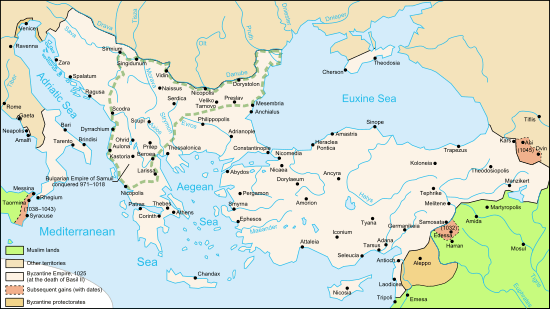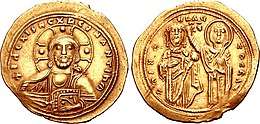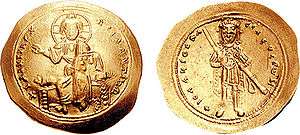Battle of Petroe
| Battle of Petroe | |||||||
|---|---|---|---|---|---|---|---|
| |||||||
| Belligerents | |||||||
| Imperial forces of Michael VI Stratiotikos | Rebel forces of Isaac I Komnenos | ||||||
| Commanders and leaders | |||||||
|
Theodore Aaron Basil Tarchaneiotes |
Isaac I Komnenos Katakalon Kekaumenos Romanos Skleros | ||||||
| Casualties and losses | |||||||
| Heavy | Significant | ||||||
The Battle of Petroe,[1] also known as the Battle of Hades,[2] was fought on 20 August 1057 between the Byzantine imperial forces of the proedros Theodore, the Domestic of the Schools of the East, and the rebellious general Isaac I Komnenos, commander of the Byzantine field army in Anatolia. Komnenos had rebelled against Michael VI Stratiotikos (r. 1056–1057) and won the allegiance of many leading generals, including Nikephoros Bryennios and Nikephoros Botaneiates.
After Komnenos was proclaimed emperor, the two armies clashed at Hades, near the city of Nicaea. Although the right wing of the army of Komnenos was beaten, the left wing of Komnenos's army, led by Katakalon Kekaumenos, routed the imperial right, reached and entered their camp, and destroyed their tents. Komnenos himself held firm in the centre, causing the imperial army to break and run, leaving the way open to Constantinople.
Background

When Empress Theodora, the last member of the Macedonian dynasty, died in 1056, the court circle around the empress, dominated by her household eunuchs under Leo Paraspondylos, selected Michael VI Bringas as her successor. A career bureaucrat, Michael was a weak and pliant ruler dominated by the eunuchs; given his advanced years and lack of children, his reign was perceived as weak and unlikely to last from the start, and was plagued by rebellions.[3][4] Michael VI engaged in massive promotions of individuals, but restricted this to the civilian bureaucracy, and neglected the military.[5][6] This was not a trivial matter: the debasement of the Byzantine currency under Constantine IX Monomachos (r. 1042–1054) had affected military pay—not coincidentally presided over by none other than Michael Bringas, who was then military logothete—and while civil officials were compensated by being raised to higher dignities, the army was not.[7] This exacerbated the already simmering dislike of the military aristocracy for the "regime of eunuchs and civilian politicians" that dominated the empire during the last decades of the Macedonian dynasty.[8]
In Easter 1057, a delegation of leading generals under Isaac Komnenos, Katakalon Kekaumenos, Michael Bourtzes, Constantine Doukas and John Doukas, appeared before the emperor to request similar promotions. According to the eyewitness Michael Psellos, the emperor began abusing them at once; he then made Isaac, as the leader of the deputation, and his second, Kekaumenos, stand forth, and proceeded to denounce him, claiming that he was responsible for "all but losing Antioch" and "corrupting his army", being a coward and incompetent, and of having misappropriated army funds for his own use.[9][6] The effect of the emperor's attitude on the army leadership was profound, and turned them against Michael. A second delegation to Strabospondylos was received in similar manner, and a plot was formed against the emperor, with Isaac Komnenos as its leader.[10][11]
The conspirators contacted the veteran general Nikephoros Bryennios—who had unsuccessfully tried to usurp the throne from Theodora[12] —but had recently been recalled by Michael VI as commander of the Macedonian army, and he apparently agreed to support them. Soon after, however, Bryennios left with his troops for Asia Minor, to campaign against the Turks. Once in the Anatolic Theme, however, he quarreled with the army treasurer, the patrikios John Opsaras, threw him in prison, and appropriated the funds to pay his soldiers as he saw fit. This was seen by another local commander, the patrikios Lykanthes, as an attempt at rebellion, and he marched against Bryennios and had him arrested and handed over to Opsaras, who had him blinded.[11][13]
Initial moves

Fearing that their plot was about to be discovered, the eastern generals hastened to act: the conspirators resident in the Anatolic Theme, Romanos Skleros, Michael Bourtzes, Nikephoros Botaneiates and the sons of Basil Argyros, hastened to find Isaac Komnenos at his estates near Kastamn in Paphlagonia, and on 8 June 1057, at a place called Gounaria, proclaimed him emperor.[14] It is unclear whether any of the rebels held command of troops; rather, according to Kaldellis, "they had to canvass for support among the officers and soldiers and forge orders of imperial appointment for themselves".[15] Thus Skylitzes reports that Kekaumenos had to forge imperial letters to mobilize the regiments (tagmata) of the Armeniac Theme to march against the Seljuk chieftain Samouch. Of these, three were composed of mercenaries—two Frankish and one Russian—and two were native Byzantine—those of Koloneia and Chaldia. Gathering these forces on the plain of Nikopolis, Kekaumenos marched west to join Komnenos.[16]
At the same time, the western regiments, and part of the eastern ones too (those of the Anatolic Theme and of Charsianon), remained loyal to Michael VI. The emperor placed them under the command of Theodora's eunuch favourite, the proedros Theodore, who was the domestikos ton scholon (commander-in-chief) of the East, and the magistros Aaron, Isaac's brother-in-law; unlike previously, he now "showered the commanders and the soldiers with honours, gifts and extravagant grants of money" to secure their allegiance. The loyalist army crossed over into Anatolia at Chrysopolis and assembled at Nicomedia, controlling the direct route to the capital. Advance detachments were sent to demolish the Sangarius Bridge, while the army established a fortified camp at Mount Sophon.[17][18] Leaving his family with his brother at the fortress of Pemolissa on the banks of the Halys River, Komnenos in turn slowly advanced west towards Constantinople. Finding the imperial army blocking the direct route to the capital, Komnenos turned south and seized Nicaea as his base of operations. He then established his own fortified camp some 12 miles north of the city.[15][17]
The battle

Both sides sent soldiers out to forage and collect wood, and over several days, the soldiers from both camps, often friends and relatives, met one another and tried to persuade the other side to defect. Initially, the commanders of the two armies tried to take advantage of that, sending skilled men to induce the other side to defect, but without much effect. Finally Isaac Komnenos ordered his men to stay closer to their camp, and to be more careful in contact with the loyalists. This was interpreted by the loyalist soldiers as a sign of weakness, and they urged the proedros Theodore to fight. Reluctantly, the latter agreed to leave Sophon and encamp at Petroes, some 15 stadia from the rebel camp.[2] Finally, Komnenos marched out his forces and arrayed them for battle on a plain called, according to Michael Attaleiates, Polemon or Hades (Haides according to John Skylitzes).[2][18]
Kekaumenos commanded the left wing, Romanos Skleros the right, and Komnenos positioned himself in the centre. On the imperial side, the magistros Aaron was stationed on the left wing with Lykanthes, Pnyemis the Iberian (commander of the forces of Charsianon) and the patrikios Randolf the Frank as his lieutenants; Basil Tarchaneiotes (the stratelates of the western armies) was positioned on the right, and the centre was commanded by the proedros Theodore.[2] In the ensuing battle, the imperial left wing under Aaron completely routed the rebel right wing. Pursuing them to the rebel camp, he captured Romanos Skleros there and was on the cusp of seizing the rebel camp and victory along with it: Skylitzes reports that Komnenos was on the verge of fleeing to Nicaea. However, Aaron hesitated, and allowed the rebel army time to reverse the situation.[2] In the centre, Komnenos held out against heavy loyalist pressure; Psellos reports that four "Tauroscythian" (an anachronistic term for the Russians) mercenaries tried to kill him, but failed; indeed, by attacking him with from two sides, their lances got stuck in his armour and kept him aloft, balanced in the middle.[19] On the rebel left, Kekaumenos routed the loyalist right, breaching their camp and destroying their tents. As the camp was situated on a height and was widely visible, this encouraged the rebels and dejected the loyalists, who collapsed and fled. During the pursuit, many prisoners were taken and many killed, including the imperial generals Maurokatakalos, Pnyemios and Katzamountes.[20] Nikephoros Botaneiates won particular renown at this point: Randolf the Frank was caught up in the rout when he saw Botaneiates leading an attacking division. Shouting a war cry, Randolf turned and attacked Botaneiates; the two engaged in single combat until Randolf's sword broke and he was captured.[21][22]
Aftermath
While the remnants of the imperial army withdrew to the capital, Komnenos moved to occupy Nicomedia. There he was met by envoys of the Emperor: Michael Psellos, and the proedroi Constantine Leichoudes and Theodore Alopos, who offered him the title of Caesar if he would cease his rebellion. Although these proposals were publicly rejected, privately Komnenos showed himself more open to negotiation, and he was promised the status of co-emperor. During the course of these secret negotiations, a riot in favour of Komnenos broke out in Constantinople. The patriarch Michael Keroularios convinced Michael VI to abdicate in Komnenos's favour on 31 August 1057. Komnenos entered Constantinople on 1 September and was crowned emperor the same day.[4][23]
References
- ↑ Vogt (1923), pp. 117–118
- 1 2 3 4 5 Wortley 2010, p. 460.
- ↑ Kaldellis 2017, pp. 215–216.
- 1 2 ODB, "Michael VI Stratiotikos" (C. M. Brand), p. 1366.
- ↑ Sewter 1953, pp. 209–210.
- 1 2 Wortley 2010, pp. 450–451.
- ↑ Treadgold 1997, p. 597.
- ↑ Kaldellis 2017, p. 217.
- ↑ Sewter 1953, p. 210.
- ↑ Sewter 1953, pp. 210–211.
- 1 2 Wortley 2010, pp. 454–455.
- ↑ Kaldellis 2017, p. 215.
- ↑ Kaldellis 2017, pp. 217–218.
- ↑ Wortley 2010, pp. 455–456.
- 1 2 Kaldellis 2017, p. 218.
- ↑ Wortley 2010, pp. 456–458.
- 1 2 Wortley 2010, pp. 458–459.
- 1 2 Kaldellis & Krallis 2012, p. 99.
- ↑ Sewter 1953, p. 215.
- ↑ Wortley 2010, pp. 460–461.
- ↑ Wortley 2010, p. 461.
- ↑ Kaldellis & Krallis 2012, p. 101.
- ↑ Wortley 2010, pp. 461–465.
Primary sources
- Kaldellis, Anthony; Krallis, Dimitris, eds. (2012). Michael Attaleiates: The History. Cambridge, Massachusetts and London: Harvard University Press. ISBN 978-0-674-05799-9.
- Sewter, Edgar Robert Ashton, ed. (1953). The Chronographia of Michael Psellus. New Haven, Connecticut: Yale University Press.
- Wortley, John, ed. (2010). John Skylitzes: A Synopsis of Byzantine History, 811–1057. Cambridge: Cambridge University Press. ISBN 978-0-521-76705-7.
Secondary sources
- Kaldellis, Anthony (2017). Streams of Gold, Rivers of Blood: The Rise and Fall of Byzantium, 955 A.D. to the First Crusade. New York: Oxford University Press. ISBN 978-0190253226.
- Kazhdan, Alexander, ed. (1991). The Oxford Dictionary of Byzantium. Oxford and New York: Oxford University Press. ISBN 0-19-504652-8.
- Treadgold, Warren T. (1997). A History of the Byzantine State and Society. Stanford, California: Stanford University Press. ISBN 978-0-8047-2630-6.
- Vogt, Albert (1923), "The Macedonian Dynasty from 976 to 1057 A.D.", The Cambridge Medieval History, Vol. IV: The Eastern Roman Empire (717–1453), Cambridge University Press, pp. 83–118, OCLC 895446365